Highlights & Sections
Exhibition Highlights
Tradition and the future – Unique approaches and methods that breathe new life into architectural heritage and link them to the future
"Architecture, Urbanism, Innovation" provides valuable insights into Foster + Partners' unique approaches and methods that involve recognizing and reclaiming the historical background and settings of traditional structures while employing state-of-the-art technology, including the redevelopment of the Reichstag, which houses the German Parliament and has become a tourist mecca in Berlin as the symbol of the reunification of Germany, and the conversion of the central courtyard of the British Museum into a beautiful glass-covered atrium known as the Great Court.
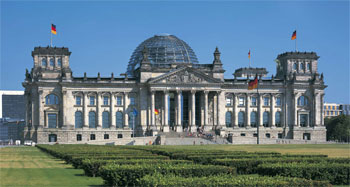
Reichstag, New German Parliament
1992-1999 Berlin, Germany
The dome of which was destroyed during World War II, was rebuilt in glass. A mirrored cone in the center of the dome directs sunlight into the chamber below. The dome symbolizes political transparency by opening up the space above the debating chamber to the public as an observation area. This observation area provides a 360-degree view of the city.
Innovative projects that will shape the cities and architecture of the near future
The exhibition also features innovative projects that will shape cities and architecture of the near future, including Apple Campus 2, a piece of sustainable architecture, and lunar habitations made from lunar soil using a robot-operated 3D printer.
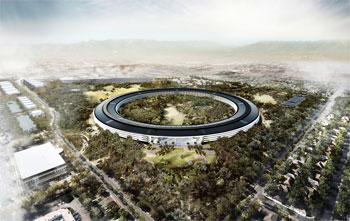
Apple Campus 2
2016 (scheduled) California, USA
Humans and the environment – A design philosophy fostered through collaborations with
R. Buckminster Fuller, famous for popularizing the concept of "Spaceship Earth"
Here we trace the origins of Foster's architecture by focusing on projects undertaken in the 12-year period from 1971 to 1983 when Foster collaborated with R. Buckminster Fuller, the engineer and philosopher who raised and proposed solutions to various global environmental problems from the 1930s onwards and who continues to have a major influence on architects and artists.
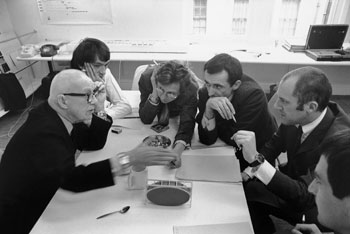
Foster Associates staff and R. Buckminster Fuller discussing
the Samuel Beckett Theatre on the right is Norman Foster 1971
A special viewing experience in a gallery space with panoramic views of Tokyo
A vast array of works including models, videos and computer graphics will be displayed in the Sky Gallery at Tokyo City View, an observation deck 250 meters above sea level, offering visitors a special viewing experience with the cityscape below. Visitors can also savor the luxury of enjoying videos in a lounge with a bird's-eye view of the whole city surrounded by furniture and other products designed by Foster + Partners.
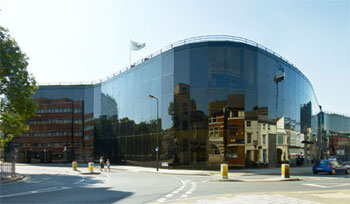
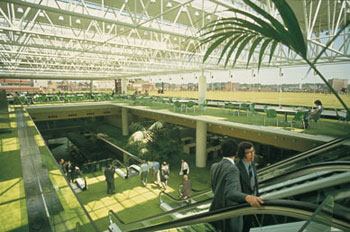
Willis Faber and Dumas Headquarters
1975 Ipswich, UK
An early masterpiece. The dark glass exterior that reflects the building's surroundings was used in an effort to harmonize it with the old part of the city. The atrium, which is filled with natural light, features a green-carpeted interior and leads to a rooftop garden. Designated a Grade 1 listed building, the highest protection category in the UK, equivalent to Japan's National Treasures.
Sections
Section 1
The Architectural Philosophy behind Foster + Partners
Between 1971 when his career was still in its early stage and 1983, Foster collaborated with R. Buckminster Fuller, one of the 20th century's foremost engineers and philosophers, and was greatly influenced by Fuller's ideas. At a time when such concepts as sustainability and ecology did not exist, Fuller, who referred to our planet as "Spaceship Earth," was among the first to point out and put forward solutions to a number of global issues confronting humankind. In this section, some of the joint projects undertaken by Foster and Fuller and present are presented as well as a selection of early works that later formed the basis of Foster + Partners Projects.
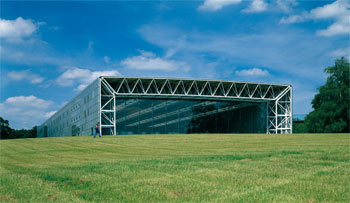
Sainsbury Centre for Visual Arts
1978 Norwich, UK
Fuller's question, "How much does your building weigh, Mr Foster?" posed to Foster during a visit to the site, became the title of the 2010 documentary film about Foster's work.
Section 2
From Space to Environment – The Foster + Partners Design Process
Here we introduce a choice selection of large-scale projects by Foster + Partners that illustrates its use of state-of-the-art design and technology in addressing issues that transcend individual countries, such as ecology, sustainability, history, tradition, region and state. Through investigative to completed models, videos, photographs and sketches, we give a sense of the design process as well as the dynamism of the creation of the architecture.
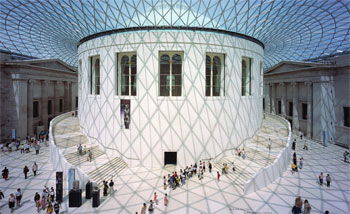
Queen Elizabeth II Great Court at the British Museum
2000 London, UK
The central courtyard of the British Museum was redeveloped into a sunlit atrium by covering the top with a glass roof while retaining the reading room that was built in 1857 in the center. The Great Court acts as a massive entrance space leading visitors to the various galleries at the museum. Each of the 3,312 glass window panels that make up the roof is an unique shape.
Section 3
Architecture, Urbanism, Innovation – Ideas for Future Lifestyles
After half a century, Foster + Partners' design practice is entering a new stage. Research is being undertaken on a number of seemingly utopian projects such as massive buildings and cities that have as their objective zero emissions and lunar habitation with an eye to turning them into reality. In this section we introduce these near-future cities and architecture supported by state-of-the-art technology.
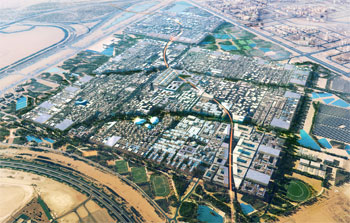
Masdar City
2007- Abu Dhabi, UAE
A 640-hectare (approx. 60 times the area of Roppongi Hills) experimental city currently under construction on the outskirts of Abu Dhabi that aims to rely completely on renewable energy source.